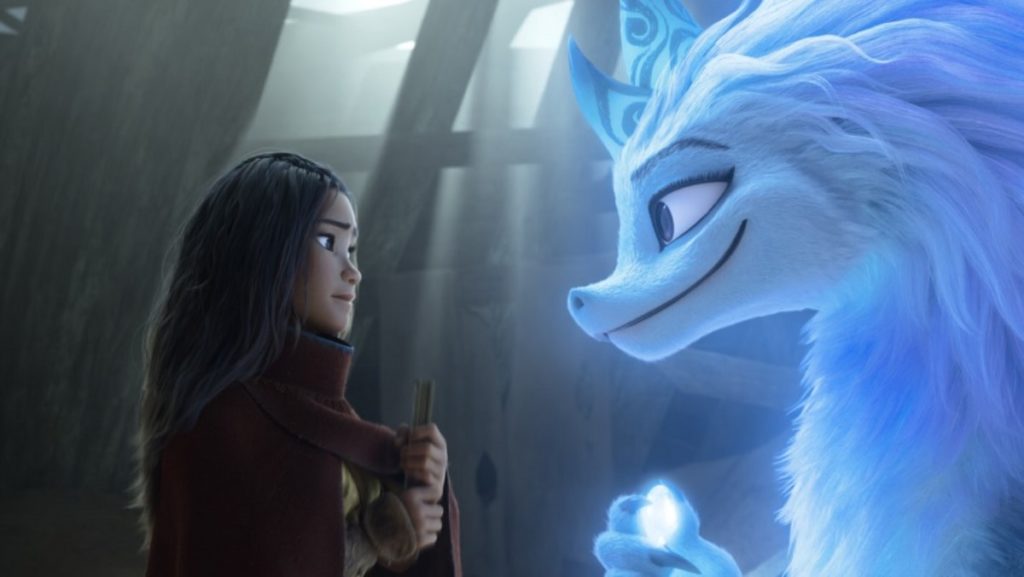Walt Disney Animation Studios has not wowed viewers with an original concept since releasing its powerhouse film “Moana” in 2016. While the 2018 “Ralph Breaks the Internet” and the 2019 “Frozen II” were both well-executed and widely acclaimed, “Raya and the Last Dragon” is the breath of fresh air that Disney fans have been waiting for.
Before diving into the beauty of the film itself, it is necessary to take a moment to appreciate the strange circumstances surrounding its production. When COVID-19 hit, the team for “Raya and the Last Dragon” was forced to work primarily from home. According to the credits of the film, this movie was made possible because of the diligence of Disney employees spread out across over 400 separate households.
After the dragons disappeared while defending humanity from a monster scourge called Druun, the fictional land of Kumandra broke apart and fell into discord. Warrior princess Raya (Kelly Marie Tran) and the last remaining dragon Sisu (Awkwafina) must come together to bring peace to Kumandra once more.
The undying passion for the product is clear. “Raya and the Last Dragon” is a true visual marvel that transcends anything Disney has ever accomplished. From fast-paced action sequences to calm wide-sweeping landscape shots, the animators squeezed every last ounce of their skill into this movie.
Some of the most fantastic aspects of the animation are the fight scenes. Raya often finds herself engaging in battle, and every encounter is a feast for the eye. With each punch, kick and sword slash, the movie effectively immerses the audience in the action. Subtleties like variations in characters’ fighting styles add a layer of gritty realism to the combat and ensure that the sequences are fast-paced and exciting.
“Raya and the Last Dragon” also brings a deeply emotional story to the table. The film is the perfect balance of suspenseful, humorous and whimsical, and guarantees to keep viewers on a wildly swinging pendulum of emotion.
The ragtag cast of characters proves to be incredibly likable. One of the most memorable performances comes from Awkwafina. While the actor is known for her comedic roles in movies like “Crazy Rich Asians” and “Ocean’s 8,” she brings a lovely, melancholic nuance to her character. She still manages to balance this delicate emotion with the goofy charm that so many viewers have come to expect from her.
The cherry on top of this fantastic film is the score. “Raya and the Last Dragon” is certainly not the first non-musical Disney animated movie to exist, but it is the first Disney princess movie from Walt Disney Animation Studios to go without plot-driving musical numbers. At first, this might seem like a risky move, but “Raya and the Last Dragon” does not need large, choreographed music sequences or sensitive ballads to make the music great. Each song on the soundtrack swims with emotion and power. It also mixes modernized synthesized elements with traditional Southeast Asian instruments, like chimes and hand drums.
Besides being impeccably written, animated and scored, “Raya and the Last Dragon” is a step forward in the recognition of Southeast Asians in media. Although the film takes place in a fantasy setting, it was heavily inspired by Southeast Asian cultures and includes nods to Vietnam, Thailand and Laos.
Disney princesses are icons for many children, and it is extremely important for Disney to use that influence for good. Raya is more than just another Disney princess — her existence leaves an opening for more people to seek social change through animation. With any luck, “Raya and the Last Dragon” is just the first in a long line of more inclusive Disney films.
While the triumph of “Raya and the Last Dragon” does not dismiss Disney’s deep, dirty history of racial inequity, it is a massive step in the right direction. Looking to the future, there is new hope that Disney will dedicate itself to not just creating other enchanting and entirely original ideas but also to continuing to right the many wrongs of its past.




















